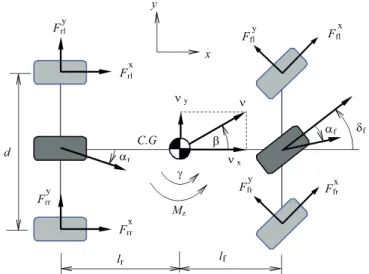Journal ofELECTRICAL ENGINEERING, VOL. 64, NO. 1, 2013, 50–54
HYBRID CONTROL OF ELECTRIC VEHICLE LATERAL DYNAMICS STABILIZATION
Khatir Tabti — Mohamend Bourahla — Lotfi Mostefai ∗
This paper presents a novel method for motion control applied to driver stability system of an electric vehicle with independently driven wheels. By formulating the vehicle dynamics using an approximating the tire-force characteristics into piecewise affine functions, the vehicle dynamics cen be described as a linear hybrid dynamical system to design a hybrid model predictive controller. This controller is expected to make the yaw rate follow the reference ensuring the safety of the car passengers. The vehicle speed is estimated using a multi-sensor data fusion method. Simulation results in Matlab/Simulink have shown that the proposed control scheme takes advantages of electric vehicle and enhances the vehicle stability.
K e y w o r d s: electric vehicle, hybrid model predictive control, yaw moment control
1 INTRODUCTION
Recently, pure electric vehicle have achieved sufficient driving performance due to important improvements in motors and batteries design technology. That, we can summarize the advantage of vehicle propelled by electric motor into the following point that the torque generation of an electric motor is very quick, accurate and can be measured easily [1].
In fact, the yaw rate of a car is influenced by distur- bance torques resulting from crosswind, breaking, and acceleration on a -split road, so on, and a conventional front-wheel steering system cannot guarantee the vehicle stability on slippery roads. An electric vehicle equipped with two individual electric motors in the rear has the advantage of another steering control input, i.e. torque steering. Stability improvement, using torque steering is
usually addressed as Direct Yaw-moment Control (DYC), [2].
In this paper, we propose a hybrid Model Predictive Control (MPC) design that the aim is to track the above indicated reference, hence providing the driver with the desired yaw rate. The major advantage of MPC is the capability of handling in a single framework multiple in- puts and outputs, constraints on inputs, states, and out- puts, and optimization with respect to a predefined per- formance criterion.
In the next Section we formulate the vehicle dynamics using the front and rear tire slip angles as the states, and the vehicle yaw rate as the output. By assuming a con- stant longitudinal velocity and approximating the func- tions that relate the tire force to the tire slip angles by a piecewise affine maps, the vehicle dynamics are reformu- lated as a linear hybrid system in piecewise affine (PWA) form. By transforming the PWA model in an equivalent
Frl y
Frl x
Ffr y
Frr y
Ffl
y Ffl
x
Frr x
Ffr x
x
af
ny
nx
n
ar
df
y
lf
lr
d
C.G b
Mz
g
Fig. 1.Top-view vehicle dynamics model
∗ University of Science and Technology of Oran, Faculty of Electrical Engineering, BP 1505 El-Mnaouar, Oran, Algeria, khatir75@hotmail.com, bourah3@yahoo.fr, latyfo@hotmail.com
DOI: 10.2478/jee-2013-0007, ISSN 1335-3632 c2013 FEI STU
